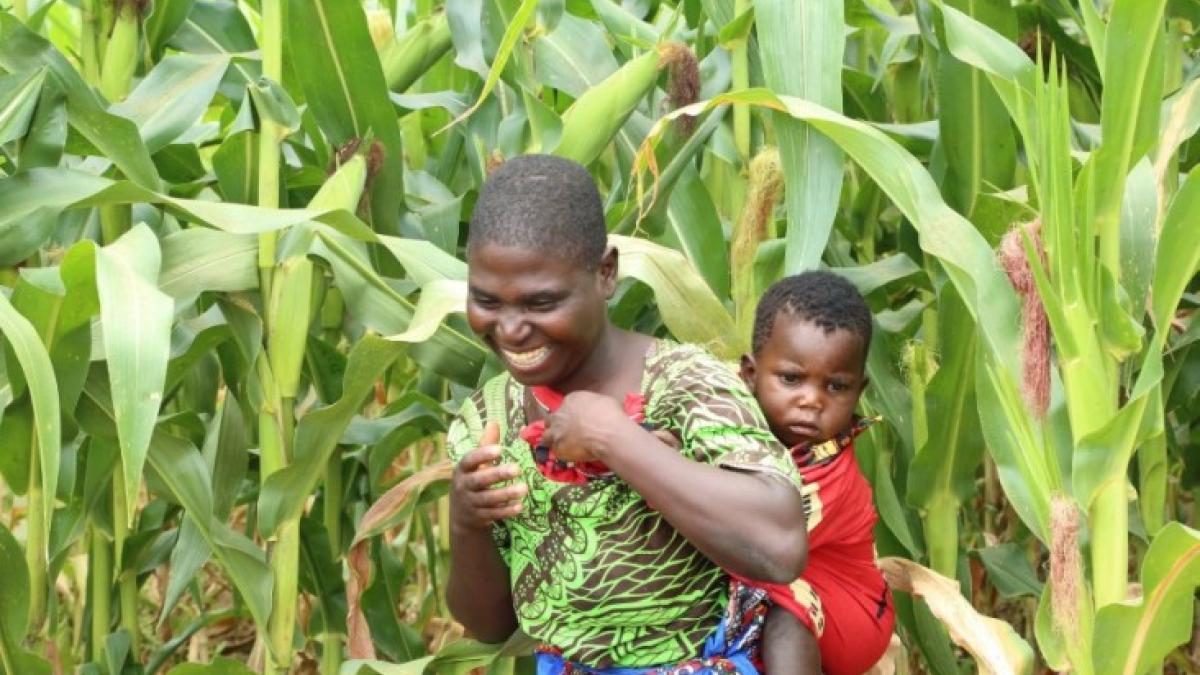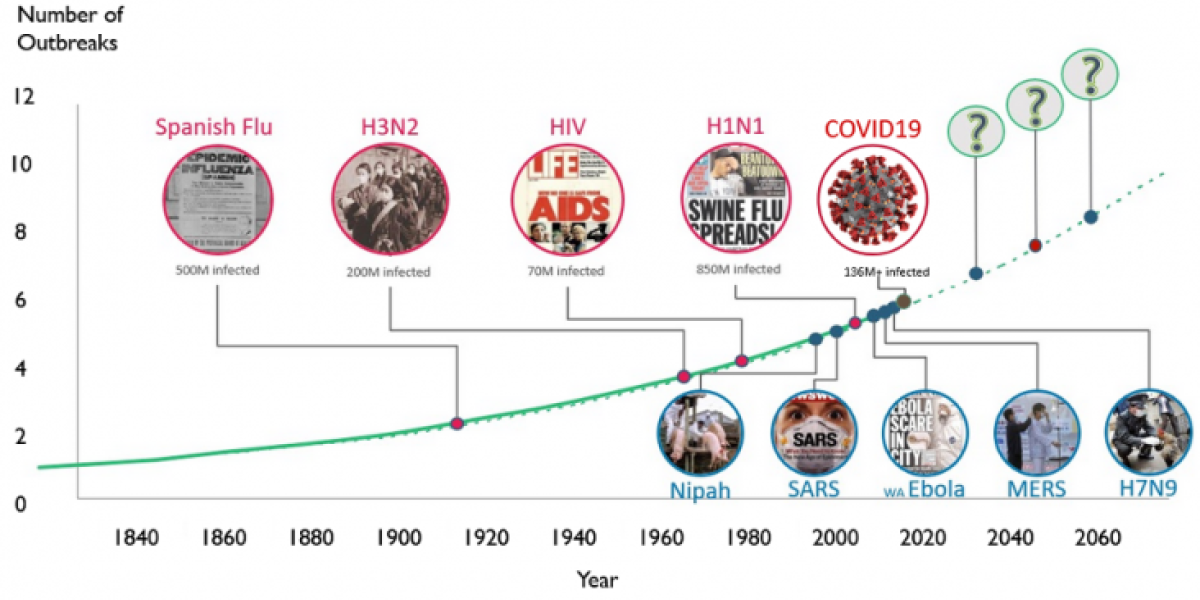
while increasing soil fertility, tree canopy, and wildlife habitat.
Jonathan Odhong'/IITA
USAID and the international community are working together diligently—in a time of global climate change, pandemic, and biodiversity loss—to ensure the well-being of people, animals, and the environment on which we all depend. “One Health” is a collaborative, multisectoral, and transdisciplinary approach—working at the local, regional, national, and global levels—with the goal of achieving results that recognize the interconnection between people, animals, plants, and their shared environment. USAID is putting this approach into practice.
As COVID-19 has made us all painfully aware, there can be serious global consequences when disease-causing pathogens make the leap to humans from other animals. While the specific origins of this current pandemic are not yet clear, what is clear is the hardship it has caused: a death toll of nearly 2.9 million, 163 million more people pushed into extreme poverty in 2021, and economic damages in the trillions of dollars.
There have been many cross-species pathogen jumps in the recent past, including HIV, Ebola, and Zika viruses. In fact, more than 70 percent of emerging diseases are zoonotic: transmissible between animals and people. An estimated 1.7 million as-yet undiscovered viruses are thought to be present in mammals and birds, and as many as half of these could have the ability to infect humans.
Understanding the relationships between human health and the environment, and how we can stop diseases driven by degradation of the natural environment, are critical questions for researchers, development practitioners, policymakers, and citizens alike.

Adapted from Jones et al. (2008) Nature; modified by KB Johnson with COVID-19 worldwide case count updated as of April 2021.
Forests and Emerging Zoonotic Diseases
“The COVID-19 pandemic has been a tragic use-case, illustrating one of many reasons we need to pay attention to what happens at the interface of humans and the environment,” says Kiersten Johnson, a researcher with USAID’s Bureau for Resilience and Food Security. “How do novel zoonoses emerge? They don’t just happen. They’re the product of dynamics resulting from humans coming into contact with, and often functionally modifying, biodiverse landscapes.”
For example, when people cut trees and expand agriculture into previously wild areas, they increase contact between wildlife, livestock, and people. This escalates the risks of disease-causing pathogens jumping from wildlife to livestock and people. Often, the most dramatic land use changes, with the most dramatic consequences for human health, occur in lower-income countries, leaving already-vulnerable populations exposed to these zoonoses.
But it does not just happen in lower-income countries. In North America, tick-borne Lyme Disease, caused by the bacterium Borrelia burgdorferi, has emerged in recent decades. This bacterium circulated in forests for 60,000 years, but only began to cause widespread disease in humans as forests became fragmented through deforestation and suburbanization. Climate change is increasing the range of the Lyme-spreading black-legged tick by 28 miles further north each year.
A similar story is unfolding in China’s Yunnan Province and nearby regions of Myanmar and Laos. Climate change has driven large-scale changes in natural habitats, shifting the landscape from tropical shrubland to tropical savannah and deciduous woodland. This in turn created suitable habitat for many forest-dwelling bat species, including 40 non-native species that migrated into the region over the past century. These species host around 100 types of bat-borne coronavirus, in an area where genetic data suggests COVID-19 may have arisen.
Forests, Food, and Children’s Health
A growing body of research demonstrates the links between human health and the environment beyond emerging pandemics. According to the World Health Organization, unhealthy environments contribute to a quarter of deaths of children under 5 years old, with poor access to clean water and hygiene contributing to more than 350,000 deaths each year of diarrheal disease.
Researchers from the University of Vermont found that children who live in watersheds with more tree cover are less likely to experience diarrhea. Analyzing USAID’s Demographic and Health Surveys (DHS) data from 300,000 children in 35 countries, the researchers found that the healthier the watershed upstream, the healthier the communities downstream. A 30 percent increase in upstream tree cover in rural watersheds demonstrated effects similar to improved water and sanitation. “We are not saying trees are more important than toilets and indoor plumbing,” says lead researcher Diego Herrera. “But these findings clearly show that forests and other natural systems can complement traditional water and sanitation systems, and help compensate for a lack of infrastructure.”
An earlier study also demonstrated links between forest cover and child nutrition in Malawi: Between 2000 and 2010, children living in areas with forest cover loss were less likely to have a diverse diet and consume vitamin A-rich foods than children in areas without forest loss. Children living in areas where forest cover increased were significantly less likely to experience diarrheal disease, the second leading cause of death among children under the age of 5.
USAID and One Health Approaches
By taking a “One Health” approach, USAID is working to understand and address connections between biodiversity, food production, and human health.
For example, in Malawi, USAID’s Africa RISING program helps smallholder farming families learn agroforestry practices that integrate trees with crops and maintain a green cover on the land year-round. This allows farmers to improve food security and nutrition while increasing soil fertility, tree canopy, and wildlife habitat. It also reduces deforestation, which in turn reduces the flooding that can destroy farmers’ crops and damage their health and nutrition. Johnson says that programs like this demonstrate that it is possible to limit encroachment on wild lands “while still making sure that food systems deliver on nutrition for people who need it.”
In Thailand, USAID partnered with Thailand’s Chulalongkorn University and the Department of Livestock Development to study the bat-borne Nipah virus among the country’s pig farms. In 2017, the partnership used their research about bat-to-pig transmission to develop E-Smart Plus, an app where farmers can learn to reduce the pathogen’s risk based on inputs about their farms and associated risk factors. In 2018, the Thai Department of Livestock Development scaled up the app to be applicable to other diseases, and linked the app to the national surveillance databases, enabling the Department’s disease control agents across the country to use the app to identify risk areas. Through E-Smart Plus, 140,000 pig farms in Thailand are continuously monitoring disease risk, providing an early warning for spillover of viruses and improving farm biosecurity and management. By safeguarding the more than $3 billion pork industry, this app is contributing to Thailand’s food security, economic stability, and livelihoods. In addition, the University provided community education on living safely with bats, and avoiding coming into close contact with bats.
Building on successes like these, USAID recently launched a new cross-sectoral program called HEARTH: Health, Ecosystems, and Agriculture for Resilient, Thriving Societies. The HEARTH program includes 15 activities in 10 countries and works to advance conservation of threatened landscapes and the well-being of communities that depend on them. HEARTH does this by collaborating with private sector partners where their business objectives align with USAID’s development objectives. These projects are collaboratively designed to benefit livelihoods, human well-being, biodiversity conservation, and good governance. Working with the private sector through HEARTH allows USAID to put One Health principles into practice, generating sustainable benefits for people and the planet.
USAID and the international community are working together diligently—in a time of global climate change, pandemic, and biodiversity loss—to ensure the well-being of people, animals, and the environment on which we all depend.
